Related Research Articles

The Natural History Museum is a natural history museum located in Berlin, Germany. It exhibits a vast range of specimens from various segments of natural history and in such domain it is one of three major museums in Germany alongside Naturmuseum Senckenberg in Frankfurt and Museum Koenig in Bonn.

Lithoglyphus naticoides, the gravel snail, is a species of small or minute freshwater snail with an operculum, an aquatic gastropod mollusk in the family Lithoglyphidae.

Theodoxus fluviatilis, common name the river nerite, is a species of small freshwater and brackish water snail with a gill and an operculum, an aquatic gastropod mollusk in the family Neritidae, the nerites.

The black-bearded flying fox is an endangered species of megabat in the genus Pteropus. It is endemic to Indonesia, found on the islands of Ambon, Buru, Seram, Banda, and Yamdena. Currently considered monotypic, it formerly included the Aru flying fox and Kei flying fox as subspecies.
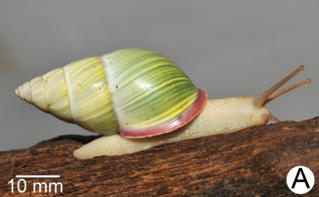
Amphidromus is a genus of tropical air-breathing land snails, terrestrial pulmonate gastropod mollusks in the family Camaenidae. The shells of Amphidromus are relatively large, from 25 mm (0.98 in) to 75 mm (3.0 in) in maximum dimension, and particularly colorful. During the 18th century, they were among the first Indonesian land snail shells brought to Europe by travelers and explorers. Since then, the genus has been extensively studied: several comprehensive monographs and catalogs were authored by naturalists and zoologists during the time period from the early 19th to the mid 20th centuries. Modern studies have focused on better understanding the evolutionary relationships within the group, as well as solving taxonomic problems.

The family Cavoliniidae is a taxonomic group of small floating sea snails, pelagic marine opisthobranch gastropod mollusks.
Apororhynchus is a genus of small parasitic spiny-headed worms. It is the only genus in the family Apororhynchidae, which in turn is the only member of the order Apororhynchida. A lack of features commonly found in the phylum Acanthocephala suggests an evolutionary branching from the other three orders of class Archiacanthocephala; however no genetic analysis has been completed to determine the evolutionary relationship between species. The distinguishing features of this order among archiacanthocephalans is a highly enlarged proboscis which contain small hooks. The musculature around the proboscis is also structured differently in this order. This genus contains six species that are distributed globally, being collected sporadically in Hawaii, Europe, North America, South America, and Asia. These worms exclusively parasitize birds by attaching themselves around the cloaca using their hook-covered proboscis. The bird hosts are of different orders, including owls, waders, and passerines. Infestation by an Apororhynchus species may cause enteritis and anemia.

Gemmula monilifera is a species of sea snail, a marine gastropod mollusk in the family Turridae, the turrids.
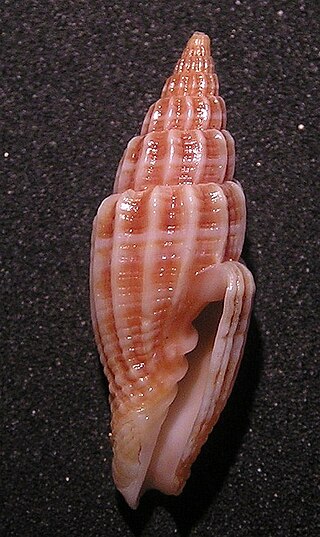
Vexillum suluense is a species of small sea snail, marine gastropod mollusk in the family Costellariidae, the ribbed miters.

Vexillum millecostatum is a species of small sea snail, marine gastropod mollusk in the family Costellariidae, the ribbed miters.
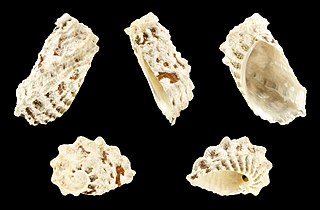
Stomatia phymotis, common name the swollen stomatella, is a species of sea snail, a marine gastropod mollusk in the family Trochidae, the top snails.

Careoradula perelegans is a species of air-breathing land snail, terrestrial pulmonate gastropod mollusk in the family Streptaxidae.
Schileykula is a genus of air-breathing land snails, terrestrial pulmonate gastropod mollusks in the family Orculidae. All of the species and subspecies in this genus inhabit Turkey, with the exception of the subspecies Schileykula scyphus crass, which lives in Iran.
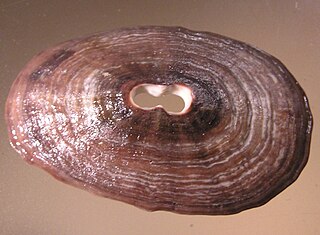
Fissurella crassa, common name the thick keyhole limpet, is a species of sea snail, a marine gastropod mollusk in the family Fissurellidae, the keyhole limpets and slit limpets.

Turridae is a taxonomic family name for a number of predatory sea snails, marine gastropod mollusks in the superfamily Conoidea.

Buccinastrum deforme, common name the collared buccinum, is a species of sea snail, a marine gastropod mollusk in the family Buccinanopsidae, the Nassa mud snails or dog whelks and the like.

Buccinastrum paytense, common name the Payta buccinum, is a species of sea snail, a marine gastropod mollusk in the family Nassariidae, the Nassa mud snails or dog whelks.
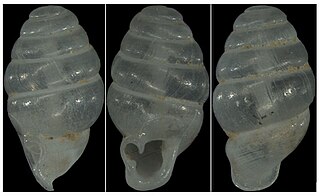
Laoennea renouardi is one of two species in the genus Laoennea of the Asian terrestrial snail family Diapheridae.
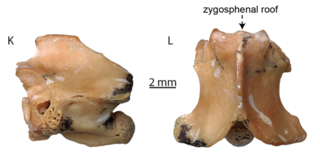
Naja romani is an extinct species of cobra from the Miocene of Europe. Its remains have been found from France to Russia and suggest a continued growth to larger sizes throughout its range in time. While successful during the early and middle stages of the Miocene, the species disappeared from the fossil record of Central Europe during the late Miocene with the last known specimen being recovered from a site in the modern Caucasus, inferred to have been a refuge for reptiles. Estimates suggest that Naja romani may have reached a length of over 2 m.
References
- 1 2 3 4 5 Hausdorf H. (1999) "A new genus of the Buliminidae from Turkey (Gastropoda: Stylommatophora)". Journal of Natural History 33: 149-154. PDF Archived 2006-10-28 at the Wayback Machine
- ↑ (in German) Retowski O. (1887) "Am Strande der Krim gefundene angeschwemmte Binnenconchylien". Malakozoologische Blatter, Neue Folge, 9: 22-42.
- ↑ (in German) Forcart L. (1961) "Systematisches Verzeichnis der von Herrn Klaus-Jürgen Gotting 1960 in der Türkei gesammelten Mollusken und Neubeschreibung einer Paramastus-Art". Archiv für Molluskenkunde 90: 175-180.